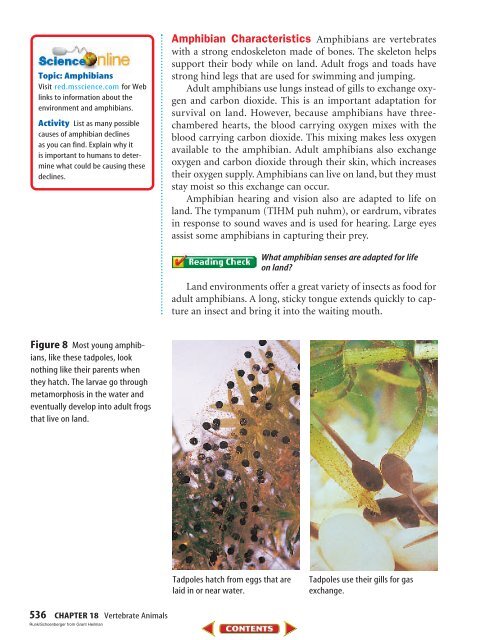Chapter 18: Vertebrate Animals
Chapter 18: Vertebrate Animals
Chapter 18: Vertebrate Animals
Create successful ePaper yourself
Turn your PDF publications into a flip-book with our unique Google optimized e-Paper software.
Topic: Amphibians<br />
Visit red.msscience.com for Web<br />
links to information about the<br />
environment and amphibians.<br />
Activity List as many possible<br />
causes of amphibian declines<br />
as you can find. Explain why it<br />
is important to humans to determine<br />
what could be causing these<br />
declines.<br />
Amphibian Characteristics Amphibians are vertebrates<br />
with a strong endoskeleton made of bones. The skeleton helps<br />
support their body while on land. Adult frogs and toads have<br />
strong hind legs that are used for swimming and jumping.<br />
Adult amphibians use lungs instead of gills to exchange oxygen<br />
and carbon dioxide. This is an important adaptation for<br />
survival on land. However, because amphibians have threechambered<br />
hearts, the blood carrying oxygen mixes with the<br />
blood carrying carbon dioxide. This mixing makes less oxygen<br />
available to the amphibian. Adult amphibians also exchange<br />
oxygen and carbon dioxide through their skin, which increases<br />
their oxygen supply. Amphibians can live on land, but they must<br />
stay moist so this exchange can occur.<br />
Amphibian hearing and vision also are adapted to life on<br />
land. The tympanum (TIHM puh nuhm), or eardrum, vibrates<br />
in response to sound waves and is used for hearing. Large eyes<br />
assist some amphibians in capturing their prey.<br />
What amphibian senses are adapted for life<br />
on land<br />
Land environments offer a great variety of insects as food for<br />
adult amphibians. A long, sticky tongue extends quickly to capture<br />
an insect and bring it into the waiting mouth.<br />
Figure 8 Most young amphibians,<br />
like these tadpoles, look<br />
nothing like their parents when<br />
they hatch. The larvae go through<br />
metamorphosis in the water and<br />
eventually develop into adult frogs<br />
that live on land.<br />
Tadpoles hatch from eggs that are<br />
laid in or near water.<br />
Tadpoles use their gills for gas<br />
exchange.<br />
536 CHAPTER <strong>18</strong> <strong>Vertebrate</strong> <strong>Animals</strong><br />
Runk/Schoenberger from Grant Heilman

















